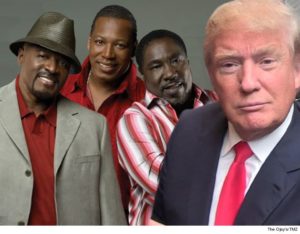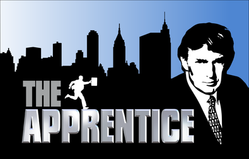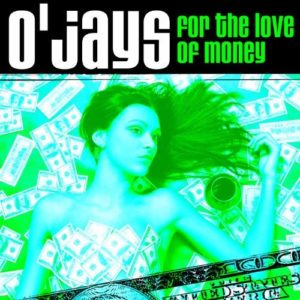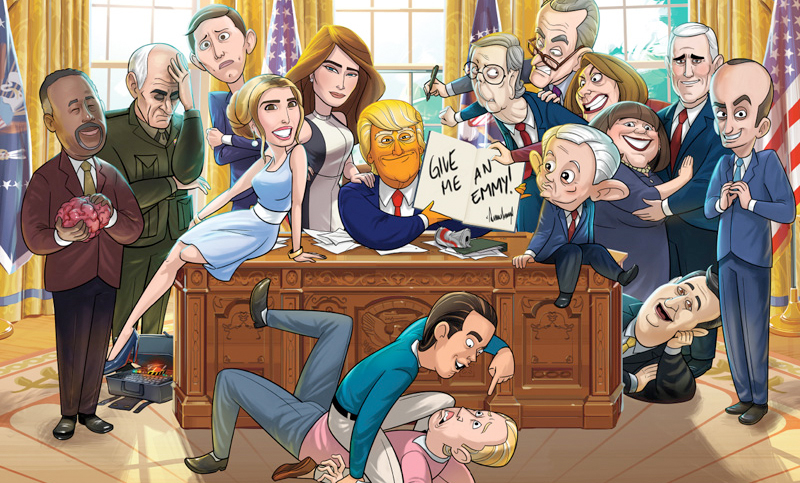
The O’Jays with Trump
Who does Trump see when he looks in the mirror? Like many of us over the proverbial hill, he likely does not acknowledge his elderly self; he sees his younger self, glamorized through the pronounced image he cultivated over decades He sees a potent man who has a younger wife and adoring fans. Even his unchanging hairdo must help reinforce his delusion.
How do we come to our view of Donald J. Trump? In this Hall of Funhouse Mirrors presidency, his distorted image has elasticity. To some who love him he is a straight-talking macho hero who satisfies a revenge fantasy against an overly sensitive multicultural society. For others he is a variegated nightmare. Is he plotting and diabolical? Stupid and incompetent? Belligerent and immature? Narcissism personified? A wily mogul? A stable genius? All or none of the above?
Melania Trump conjures up wishful thinking too. People play on the idea that she is trapped, unhappy and a secret ally to the resistance. (Maybe that’s why she plagiarizes Michelle Obama. It’s a subversive code.) On the internet, plenty of merchandise can be purchased with the joke “Free Melania.” And her woman’s heart was going to save the families at the border. HA! Her jacket with the words “I Really Don’t Care, Do U?” ought to have put an end to any such fantastic assumptions about on whose side Melania stands.
Without knowing the Trumps personally, we are at the mercy of mediated versions, most of them commercialized, invested in audience arousal. In addition to judging his actions and policies, we need a cultural understanding of Trump in order to understand our current world. Here is a short menu of offerings that entertain and inform.

As an appetizer, I urge you to start with the opening credits of “The Apprentice.” Oh come on! Watch the opening credits, at least! Educate yourselves. We need to review the imagery of yesterday from our new vantage point, the imagery of today.
Get comfy and search out Season One, Episode One. The year is 2004. Stay for five or six minutes, until the funky “For the Love of Money” by the O’Jays completes the opening montage. Watch as icons of wealth flit across the screen: stock market figures, expensive cars, actual cash, and Trump shot from a low angle advancing head-on in slow motion. See the question that worms into the mediated American soul projected across the screen in two shots: “What if / You can have it all?”


See a younger, handsome Trump, his look an amalgam of the original Rat Pack and James Bond characters. That set jaw that unnerves us today was a turn-on for some back in the day. (Eew.)
See Trump as the exemplar of the Playboy Lifestyle—first in his limo and then in his personal helicopter, casually circling Manhattan. Owning the joint.
Hear Trump’s confession which opens only the first episode. He was once in serious debt, he tells us—over an image of the national debt numbers in neon—but he says, “I used my brain. I used my negotiating skills. And I worked it all out.” It is his 2016 campaign appeal in a flashback.
Trump touts Manhattan as a “tough place,” saying “it can chew you up and spit you out”—here we see an image of a homeless man sleeping on the sidewalk—“or you can hit it big, and I mean really big.”
The first season of “The Apprentice” was an enormous success: he hit it big. Trump already had a name from years of self-promotion in gossip rags. (Despite paying no conscious attention in the 1990s, I knew who Ivana Trump was.) In his television show, Trump is famous, rich, sexy, and can take you to the top or fire your ass down. The look is glitzy, campy. But it’s a reality show. (So hey, I bet that gold toilet is real. Could it be mine?) The show pushes entrepreneurism. Wall Street, baby. Trump is the self-proclaimed “master” businessman. Words like “tycoon” and “penthouse” permeate the show.
If nothing in your world said “don’t watch this baloney,” well, “The Apprentice” could have been some light evening entertainment. Maybe you had a beer or a puff and settled down to watch this ultimate white American man. The lineup of contestants had some diversity, reinforcing the mythology that anyone can get rich if they play their cards right. Maybe the show slid into your dreams for success. Trump University was founded the same year.
Fire up Netflix for the main course, and watch a four-part documentary series produced in England, called Trump: An American Dream. Each 40- to 60-minute section, organized chronologically, is loaded with cool archival footage and, along with notable journalists, it features interviews with people who were close to Donald Trump, like his personal chauffeur for 25 years. Among other characters, we get to know his mother better, and see a younger Melania (enjoying the party life and adoring her man). We learn how Trump and pal Roger Stone studied the rise of Jesse “The Body” Ventura from popular wrestling star to Governor of Minnesota. And we hear this telling quotation from Stone on C-Span in 1999: “Here’s the fundamental question: Is the pop culture now more influential than institutions?” Hmm … seems the presidential election of 2016 offered an answer.
If time is short, go right to Episode Three: “Citizen Trump,” where we hear a younger, more cogent Trump discuss the film he identifies as his favorite. You can guess. It’s Citizen Kane. No surprise that Trump would identify with the wealthy media mogul who constructs a palace. An interviewer asks Trump what advice he would give the main character, Charles Foster Kane, towards the end of the film. His answer: “Get yourself a different woman.”
Episode Three reminds us of the Manhattan gossip scene of the 1990s, and how Donald Trump pushed onto the national stage. It features now ex-wives Ivana Trump and Marla Maples; and gossip peddlers Liz Smith, Geraldo Rivera, the New York Daily News and People magazine. Watch and get a better view of how Donald J. Trump probably sees himself.

For a light dessert and a taste of hilarity, check out Showtime’s Our Cartoon President. I suggest episode 17, the season finale: “Militarization.” The caricatures, literally finely drawn, and satiric writing will not cleanse your palette of fear and loathing, but you can get giddy seeing this dangerous man reduced to a flat, funny goof.

